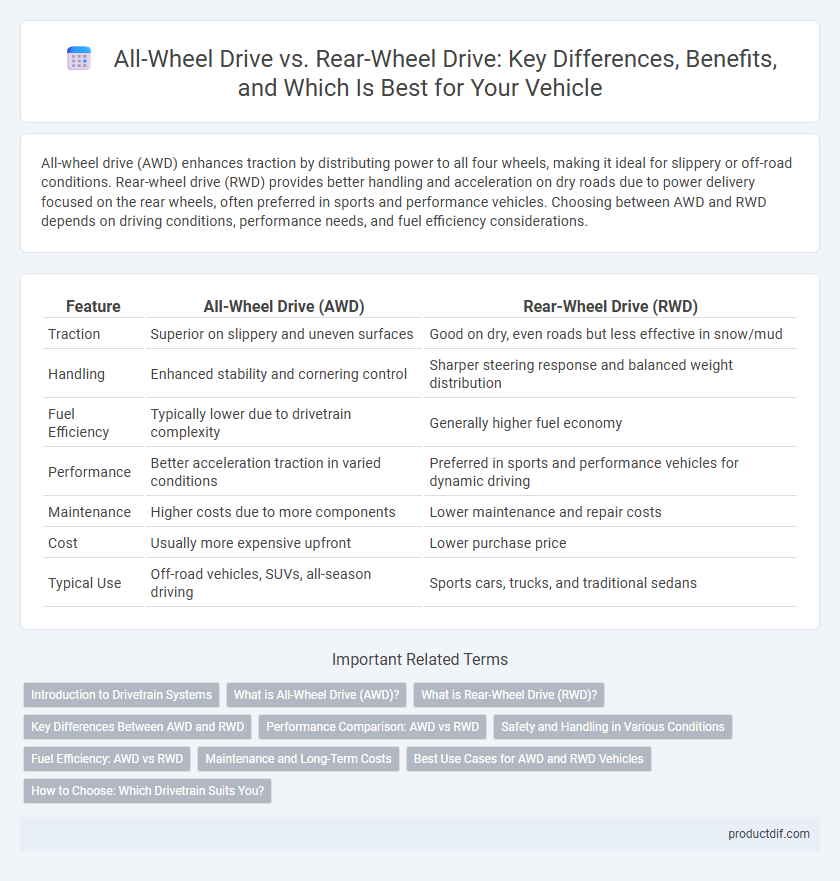All-wheel drive (AWD) enhances traction by distributing power to all four wheels, making it ideal for slippery or off-road conditions. Rear-wheel drive (RWD) provides better handling and acceleration on dry roads due to power delivery focused on the rear wheels, often preferred in sports and performance vehicles. Choosing between AWD and RWD depends on driving conditions, performance needs, and fuel efficiency considerations.
Table of Comparison
| Feature | All-Wheel Drive (AWD) | Rear-Wheel Drive (RWD) |
|---|---|---|
| Traction | Superior on slippery and uneven surfaces | Good on dry, even roads but less effective in snow/mud |
| Handling | Enhanced stability and cornering control | Sharper steering response and balanced weight distribution |
| Fuel Efficiency | Typically lower due to drivetrain complexity | Generally higher fuel economy |
| Performance | Better acceleration traction in varied conditions | Preferred in sports and performance vehicles for dynamic driving |
| Maintenance | Higher costs due to more components | Lower maintenance and repair costs |
| Cost | Usually more expensive upfront | Lower purchase price |
| Typical Use | Off-road vehicles, SUVs, all-season driving | Sports cars, trucks, and traditional sedans |
Introduction to Drivetrain Systems
All-wheel drive (AWD) systems distribute power to all four wheels simultaneously, providing enhanced traction and stability on various road surfaces. Rear-wheel drive (RWD) systems channel power exclusively to the rear wheels, offering improved handling dynamics and weight distribution for performance driving. Understanding drivetrain configurations helps drivers select vehicles suited to their specific driving conditions and performance preferences.
What is All-Wheel Drive (AWD)?
All-Wheel Drive (AWD) is a drivetrain system that distributes power to all four wheels simultaneously, enhancing traction and stability on various road conditions. AWD systems continuously monitor wheel slip and automatically adjust power distribution between the front and rear axles to optimize grip. This technology improves vehicle control in wet, snowy, or off-road environments compared to Rear-Wheel Drive (RWD), which powers only the rear wheels.
What is Rear-Wheel Drive (RWD)?
Rear-Wheel Drive (RWD) is a vehicle drivetrain configuration where the engine's power is transmitted exclusively to the rear wheels, providing improved handling and acceleration balance. RWD systems enhance steering precision by separating the tasks of steering and propulsion between the front and rear axles. Commonly found in sports cars, luxury vehicles, and trucks, RWD offers better weight distribution and performance dynamics compared to front-wheel or all-wheel drive systems.
Key Differences Between AWD and RWD
All-Wheel Drive (AWD) systems distribute power to all four wheels simultaneously, enhancing traction and stability on slippery or uneven surfaces, making them ideal for off-road and adverse weather conditions. Rear-Wheel Drive (RWD) powers only the rear wheels, offering improved handling dynamics and acceleration performance, particularly favored in sports cars and performance-oriented vehicles. While AWD provides superior grip and safety in varied driving scenarios, RWD delivers a more engaging driving experience with better balance and weight distribution.
Performance Comparison: AWD vs RWD
All-wheel drive (AWD) delivers superior traction and stability by distributing power to all four wheels, enhancing acceleration and cornering performance on diverse road conditions such as wet, snowy, or off-road surfaces. Rear-wheel drive (RWD) offers a dynamic driving experience with precise handling and better weight distribution, favored in performance vehicles due to improved balance and responsiveness during high-speed maneuvers. While AWD excels in grip and control, RWD allows for more agile and spirited driving, making the choice dependent on driving style and environmental factors.
Safety and Handling in Various Conditions
All-Wheel Drive (AWD) systems enhance vehicle safety by distributing power to all four wheels, improving traction on slippery surfaces such as snow, rain, and ice. Rear-Wheel Drive (RWD) offers superior handling dynamics on dry pavement, providing better weight distribution and steering feel for performance driving. AWD excels in maintaining stability and control in various weather conditions, while RWD prioritizes precision and responsiveness under dry, controlled environments.
Fuel Efficiency: AWD vs RWD
All-Wheel Drive (AWD) systems typically consume more fuel than Rear-Wheel Drive (RWD) due to the additional power sent to all four wheels, increasing drivetrain weight and mechanical drag. RWD vehicles often achieve better fuel efficiency, especially in dry conditions, as power is delivered to only two wheels, which reduces energy losses. Fuel consumption differences vary by vehicle type and driving conditions but generally favor RWD for lower fuel usage in everyday driving.
Maintenance and Long-Term Costs
All-wheel drive (AWD) systems generally incur higher maintenance and long-term costs compared to rear-wheel drive (RWD) due to the complexity of additional components such as differentials, transfer cases, and driveshafts requiring regular servicing. Rear-wheel drive vehicles tend to have fewer drivetrain parts, resulting in simpler repairs and lower expenses over the vehicle's lifespan. Tire wear on AWD systems can also be more expensive since all four tires often need to be replaced simultaneously to avoid drivetrain damage.
Best Use Cases for AWD and RWD Vehicles
All-Wheel Drive (AWD) vehicles excel in slippery or off-road conditions, providing enhanced traction and stability by distributing power to all four wheels, making them ideal for snow, rain, and rugged terrain. Rear-Wheel Drive (RWD) vehicles offer superior handling and balance on dry pavement, preferred for performance driving and towing due to better weight distribution and responsiveness. AWD suits SUVs and crossovers used in varying climates, while RWD benefits sports cars and trucks used primarily on paved roads.
How to Choose: Which Drivetrain Suits You?
Choosing between all-wheel drive (AWD) and rear-wheel drive (RWD) depends on your driving conditions and performance needs. AWD provides superior traction and stability on wet, snowy, or off-road surfaces, making it ideal for drivers in varied climates or rugged terrain. RWD offers better handling and acceleration on dry pavement, preferred by enthusiasts seeking sporty driving dynamics or those in regions with mild weather.
All-Wheel Drive vs Rear-Wheel Drive Infographic

 productdif.com
productdif.com